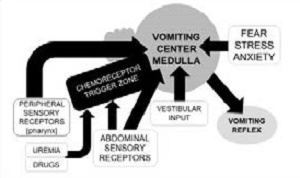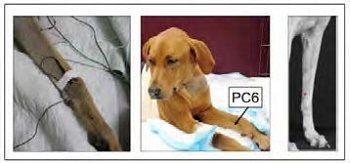S. Robertson
Vomiting
Vomiting is defined as vigorous and coordinated contractions of the diaphragm and abdominal muscles; stomach contents are ejected from the mouth. There are multiple causes of vomiting which may be acute and short lived or chronic and protracted (Figure 1). In the perioperative period this is unpleasant for the patient and associated with adverse consequences including but not limited to increased intraocular and intracranial pressure and aspiration of stomach contents.
Figure 1. Summary of the multiple inputs to the chemoreceptor trigger zone and vomiting center

Maropitant citrate (Cerenia®, Zoetis) is the most widely used anti-emetic drug in the perioperative setting. It is a potent anti-emetic agent and has the advantage of being available in an injectable and oral formulation. It is a highly specific neurokinin-1 (NK-1) antagonist and is effective against centrally and peripherally mediated vomiting by blocking the actions of substance P at the NK-1 receptor. It is an impressive anti-emetic drug, but it should not be relied upon if gastro-esophageal reflux is a concern.1 If dogs and cats suffer from motion sickness the owner can administer maropitant citrate at home prior to the journey to the clinic; this is beneficial for the pet, and owners are less distressed.
Table 1
|
Drug
|
Mode of action
|
|
Metoclopramide
|
D2-Dopaminergic antagonist
|
|
Maropitant
|
NK1-antagonist
|
|
Ondansetron
|
5-HT3-antagonist
|
|
Chlorpromazine
|
Dopamine receptor blockade
|
|
Acepromazine
|
Dopamine receptor blockade
|
|
Meclizine
|
H1-antagonist
|
Despite its anti-emetic efficacy maropitant does not appear to be as effective for nausea.2 The timing of administration is important and suggestions for dosing are shown in Table 2.
Table 2. Dosing suggestions (route, dose and timing) for maropitant citrate
|
Species
|
Indication
|
Route/dose
|
Comments
|
|
Dog
|
Prevention of acute vomiting, e.g., emetogenic opioids
Prevention of motion sickness
|
IV 1 mg/kg
SC 1 mg/kg
PO 2 mg/kg
|
60 minutes prior to triggering event. Give over 1–2 minutes.
45–60 minutes prior to triggering event
≥2 hours before the triggering event
|
|
Cat
|
Prevention of drug-induced vomiting, e.g., morphine, dexmedetomidine
Prevention of motion sickness
|
IV 1 mg/kg
SC 1 mg/kg
PO 8 mg/CAT
|
Timing is as for the dog
If given IV, administer over 1–2 minutes
|
Nausea
Nausea is an unpleasant subjective experience that is difficult to assess in dogs and cats. Humans report it as one of the most unpleasant feelings, often ranking it above pain in the perioperative environment. As with vomiting there are multiple causes; opioid and alpha2-adrenergic agonists are common causes in the perianesthetic setting. Treatment for the signs of nausea should be initiated quickly to prevent anxiety and stress for the patient. Nausea scores and response to treatment should be monitored and recorded in a pet’s record so it can be prevented or treated prophylactically during future clinic visits. One example of a scoring system is given in Table 3.
Table 3. A tool for monitoring nausea—designed for dogs2 but can be adapted for cats
|
|
1
|
2
|
3
|
4
|
|
Lip licking or swallowing
|
None
|
Occasional
|
Moderate
|
Frequent
|
|
Salivation
|
None
|
Slight
|
Moderate
|
Excessive
|
|
Panting
|
None
|
Occasional
|
Increased
|
Most of the time
|
|
Attitude, mentation posture
|
Normal
|
Mild restlessness
Depressed
Sitting, standing
Lying down
|
Very restless
Pacing
Head extended
|
Looks uncomfortable
|
Ondansetron, a 5-HT3 receptor antagonist, is an effective anti-emetic and anti-nausea drug in many species including humans. Because 5-HT3 receptors are present on abdominal vagal afferent nerves and in the chemoreceptor trigger zone ondansetron has both a peripheral and central effect. In cats it is very effective for preventing vomiting, nausea and salivation caused by dexmedetomidine—it is only effective when co-administered with dexmedetomidine.3
Ondansetron is available in oral and injectable formulations. In cats, the bioavailability via the subcutaneous and oral route are 75% and 32% respectively.4 Although an attractive route of administration in cats, transdermal application of ondansetron in a lipoderm gel did not result in clinically relevant absorption as measured by serum concentrations.5
Fear, Stress and Anxiety
One of the commonly overlooked causes of vomiting and nausea is related to emotional states such as fear, stress and anxiety (Figure 1). This underpins the need to embrace low stress and fear free techniques at all times during a patient’s hospital stay.
The Role of Acupuncture for Vomiting and Nausea
There is a long history on the use of acupuncture (AP) for the prevention and alleviation of nausea and vomiting.
In humans it has helped reduce the severity of morning sickness and chemotherapy related gastrointestinal side-effects. The main point of interest is the pericardium
(PC) 6, sometimes referred to as the “sea sickness” point or Neiguan (inner gate). In dogs, electroacupuncture at PC 6 significantly reduced the number of vomiting and retching events following morphine administration compared to treatment with saline or stimulation of a sham AP point.2 In the same study, acupuncture and acepromazine were more effective in mitigating nausea than maropitant.2 Another study reported that pretreatment with AP at PC 6 reduced the incidence of vomiting in dogs given hydromorphone from 74% to 37%.6 Even with no training in acupuncture, this is a site that is easy to locate and utilize; the use of acupuncture needles is not essential and acupressure can be applied here (Figure 3).
Figure 2. Electroacupuncture at PC 6 (left), location of PC 6 (center and right)

References
1. Johnson RA. Maropitant prevented vomiting but not gastroesophageal reflux in anesthetized dogs premedicated with acepromazine-hydromorphone. Vet Anaesth Analg. 2014;41(4):406–10.
2. Koh RB, Isaza N, Xie H, Cooke K, Robertson SA. Effects of maropitant, acepromazine, and electroacupuncture on vomiting associated with administration of morphine in dogs. J Am Vet Med Assoc. 2014;244(7):820–9.
3. Santos LC, Ludders JW, Erb HN, Martin-Flores M, Basher KL, Kirch P. A randomized, blinded, controlled trial of the antiemetic effect of ondansetron on dexmedetomidine-induced emesis in cats. Vet Anaesth Analg. 2011;38(4):320–7.
4. Quimby JM, Lake RC, Hansen RJ, Lunghofer PJ, Gustafson DL. Oral, subcutaneous, and intravenous pharmacokinetics of ondansetron in healthy cats. J Vet Pharmacol Ther. 2014;37(4):348–53.
5. Zajic LB, Herndon AK, Sieberg LG, Caress AL, Morgan PK, Hansen RJ, et al. Assessment of absorption of transdermal ondansetron in normal research cats. J Feline Med Surg. 2017;19(12):1245–8.
6. Scallan EM, Simon BT. The effects of acupuncture point pericardium 6 on hydromorphone-induced nausea and vomiting in healthy dogs. Vet Anaesth Analg. 2016;43(5):495–501.